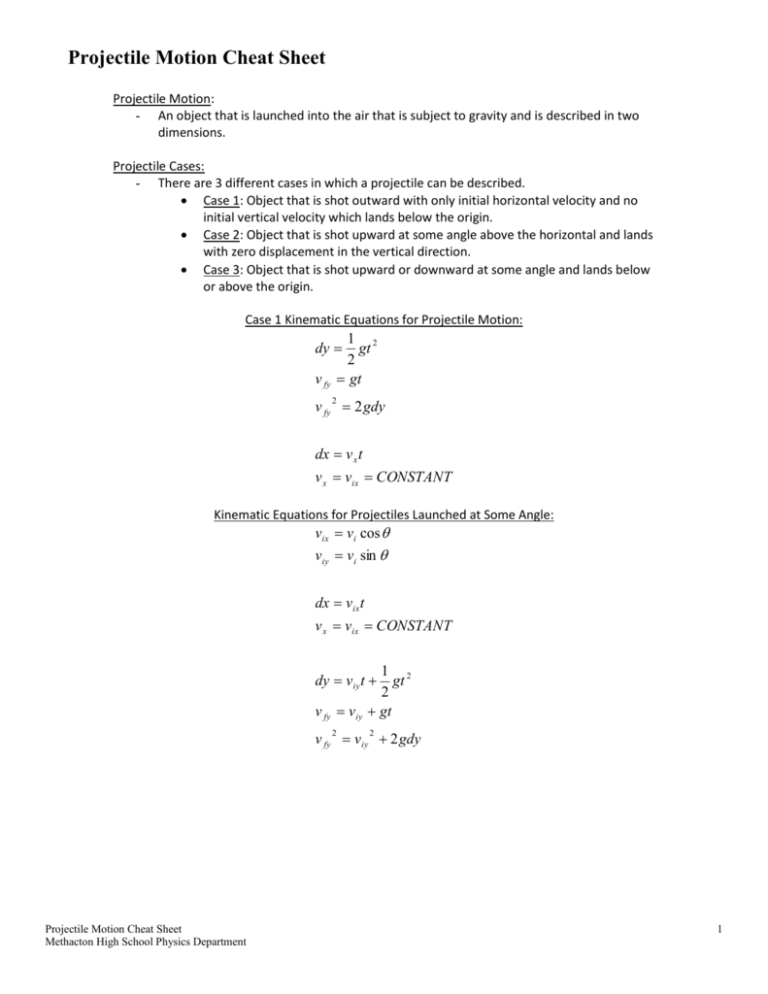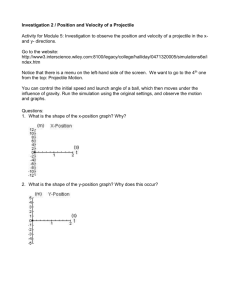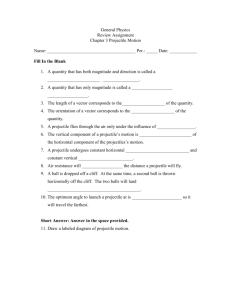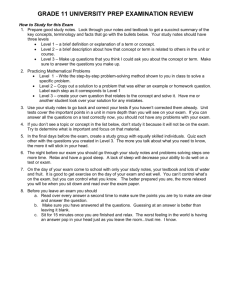Projectile Motion Cheat Sheet - Physics Equations & Tips
advertisement

Projectile Motion Cheat Sheet Projectile Motion: - An object that is launched into the air that is subject to gravity and is described in two dimensions. Projectile Cases: - There are 3 different cases in which a projectile can be described. Case 1: Object that is shot outward with only initial horizontal velocity and no initial vertical velocity which lands below the origin. Case 2: Object that is shot upward at some angle above the horizontal and lands with zero displacement in the vertical direction. Case 3: Object that is shot upward or downward at some angle and lands below or above the origin. Case 1 Kinematic Equations for Projectile Motion: 1 2 gt 2 v fy gt dy v fy 2 gdy 2 dx v x t v x vix CONSTANT Kinematic Equations for Projectiles Launched at Some Angle: vix vi cos viy vi sin dx vix t v x vix CONSTANT 1 2 gt 2 v fy viy gt dy viy t v fy viy 2 gdy 2 Projectile Motion Cheat Sheet Methacton High School Physics Department 2 1 Special Case II Equations for Projectile Motion: y max vi sin 2 2g 2v sin t (range) i g v sin t (max height ) i g v sin 2 Range i g 2 Key Hints to Solving Projectile Motion Problems: - Draw a picture representing the problem. - Set up the variables for both x- and y-directions of the projectile and fill in the given information. The same rules apply as for the kinematic equations. You need to know 3 to solve the problem, 1 you don’t need and the other you are going to solve for. 𝑣𝑖𝑥 = 𝑣𝑖𝑦 = 𝑡= 𝑣𝑓𝑦 = 𝑑𝑥 = 𝑎𝑦 = 𝑡= 𝑑𝑦 = - Time “t” is independent of the horizontal and vertical motion. It’s the variable used to relate both axis together in the problem. For most problems, solve for “t” in one direction and use it in the other direction to solve the problem. “t” for both directions will be equal to one another. - Velocity in the x-direction or horizontal velocity remains a constant throughout the motion of the projectile. Therefore the acceleration in the x-direction is zero. - Velocity in the y-direction resembles the motion of an object in free fall. - When solving case 2 or case 3 projectile motion problems where the initial velocity is given in the problem, first split the initial velocity into its horizontal and vertical velocities. - Special case II equations for projectile motion are to be used as a last resort for solving problems in projectile motion when all else fails. o ymax – It’s the maximum height a projectile will reach when launched upward at some angle. o t(range) – The time it takes a projectile to reach the range. o t(max height) – The time it takes a projectile to reach maximum height. o range – The distance a projectile will cover horizontally after the projectile is launched at some upward angle with zero displacement in the vertical direction. Projectile Motion Cheat Sheet Methacton High School Physics Department 2








